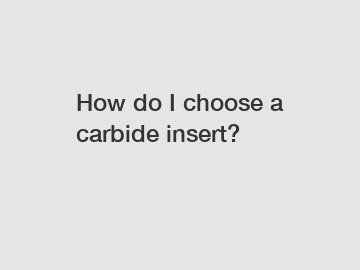How do I choose a carbide insert?
How do I choose a carbide insert?
Choosing the right carbide insert can be a crucial decision for anyone involved in machining and manufacturing. Carbide inserts are widely used in metal cutting and forming operations due to their exceptional hardness, strength, and resistance to wear. However, the selection process can be complex, considering the diverse range of options available in the market. In this article, we will explore the factors to consider when selecting a carbide insert, discuss the significance and impact of making the right choice, and provide a step-by-step guide to aid in the decision-making process.
To begin with, the choice of carbide insert depends on the specific machining requirements. Different materials, such as steel, stainless steel, cast iron, and non-ferrous alloys, require different carbide grades and geometries to achieve optimum performance. The type of operation, such as turning, milling, drilling, or threading, also influences the selection process. Additionally, the desired surface finish, cutting speed, and depth of cut play a significant role in determining the appropriate insert.

There are several factors to consider when selecting a carbide insert, including the insert geometry, cutting edge angle, and chipbreaker design. The insert geometry affects tool life, cutting forces, and chip control. For example, a positive geometry with a sharp cutting edge is suitable for low cutting speeds and light machining, while a negative geometry is more suitable for high cutting speeds and heavy machining. The cutting edge angle determines the direction of cutting forces and the shape of the chip, which affects chip evacuation and surface finish. The chipbreaker design helps in controlling chip flow and preventing chip jamming, which can lead to poor surface finish and tool failure.
Furthermore, the choice of carbide grade is crucial for achieving optimal performance and tool life. Carbide grades are classified based on their composition, grain size, and binder content. Grades with high cobalt content provide excellent resistance to heat and wear, making them suitable for high-speed machining of difficult-to-machine materials. On the other hand, grades with low cobalt content offer high hardness and toughness, making them ideal for interrupted cutting and roughing applications.
Making the right choice when selecting a carbide insert is essential as it directly affects the machining process's efficiency, productivity, and cost-effectiveness. A well-chosen insert can significantly improve cutting speeds, reduce cycle times, and extend tool life. Moreover, it can result in better surface finish, dimensional accuracy, and overall product quality. On the contrary, using the wrong insert can lead to premature tool failure, increased downtime, and higher production costs.
In conclusion, selecting a carbide insert requires careful consideration of various factors, including the specific machining requirements, insert geometry, cutting edge angle, chipbreaker design, and carbide grade. Making the right choice can have a profound impact on the machining process's efficiency, productivity, and cost-effectiveness. By understanding the principles behind carbide insert selection and following a systematic decision-making process, one can ensure optimal performance, extended tool life, and superior quality outcomes.
Contact us to discuss your requirements of Tungsten Carbide Round Bar, tungsten carbide teeth inserts, carbide rods cutter factory. Our experienced sales team can help you identify the options that best suit your needs.
221
0
0

Comments
All Comments (0)